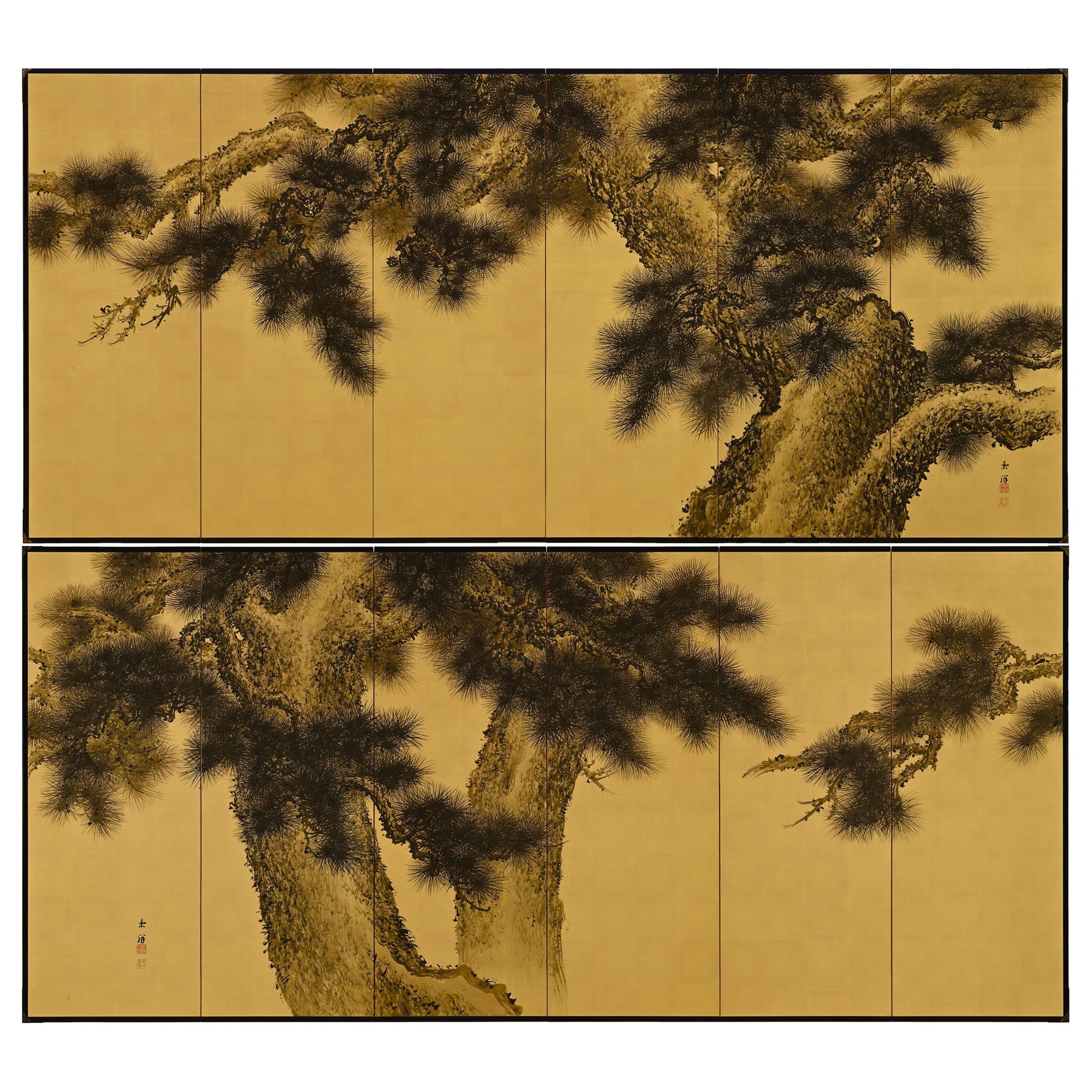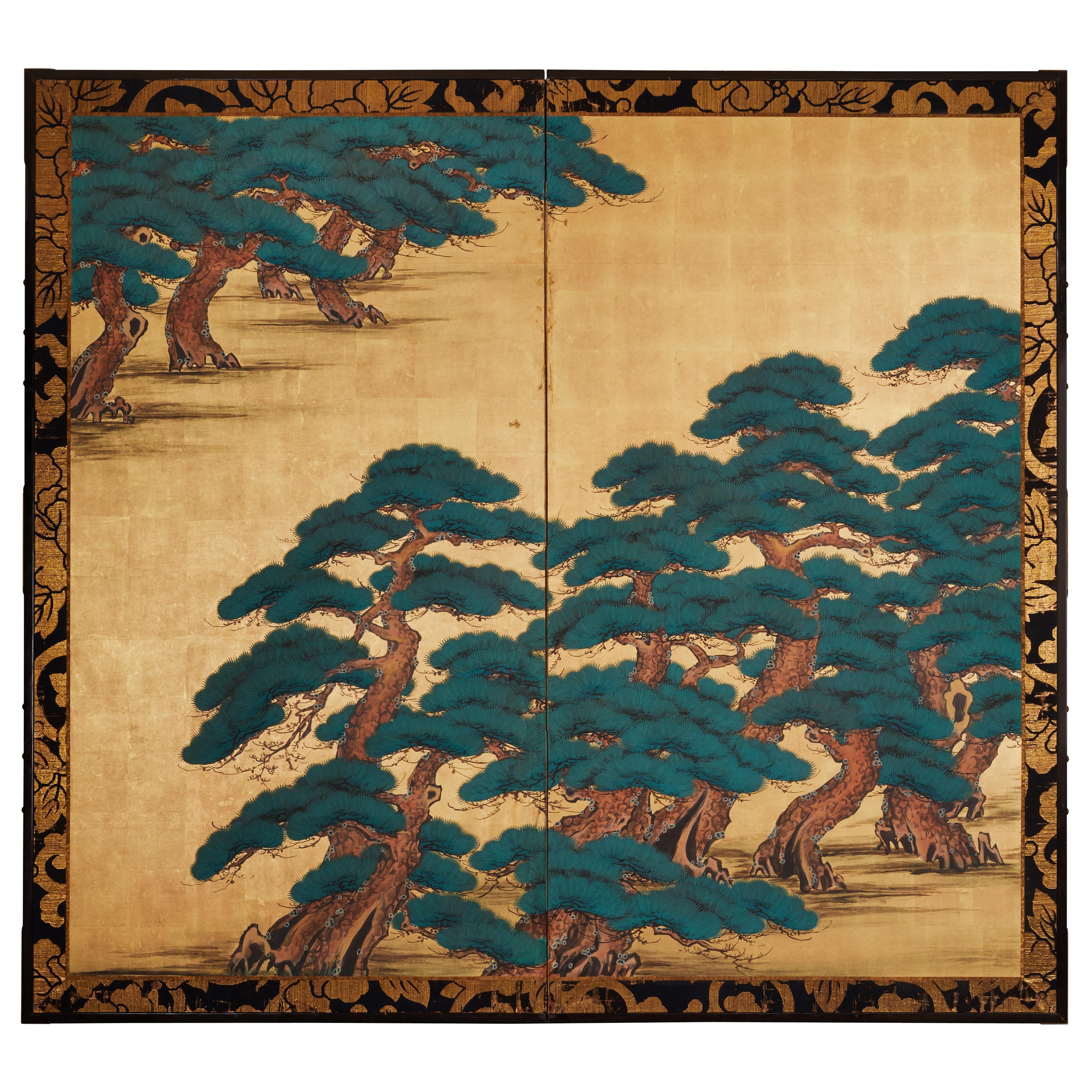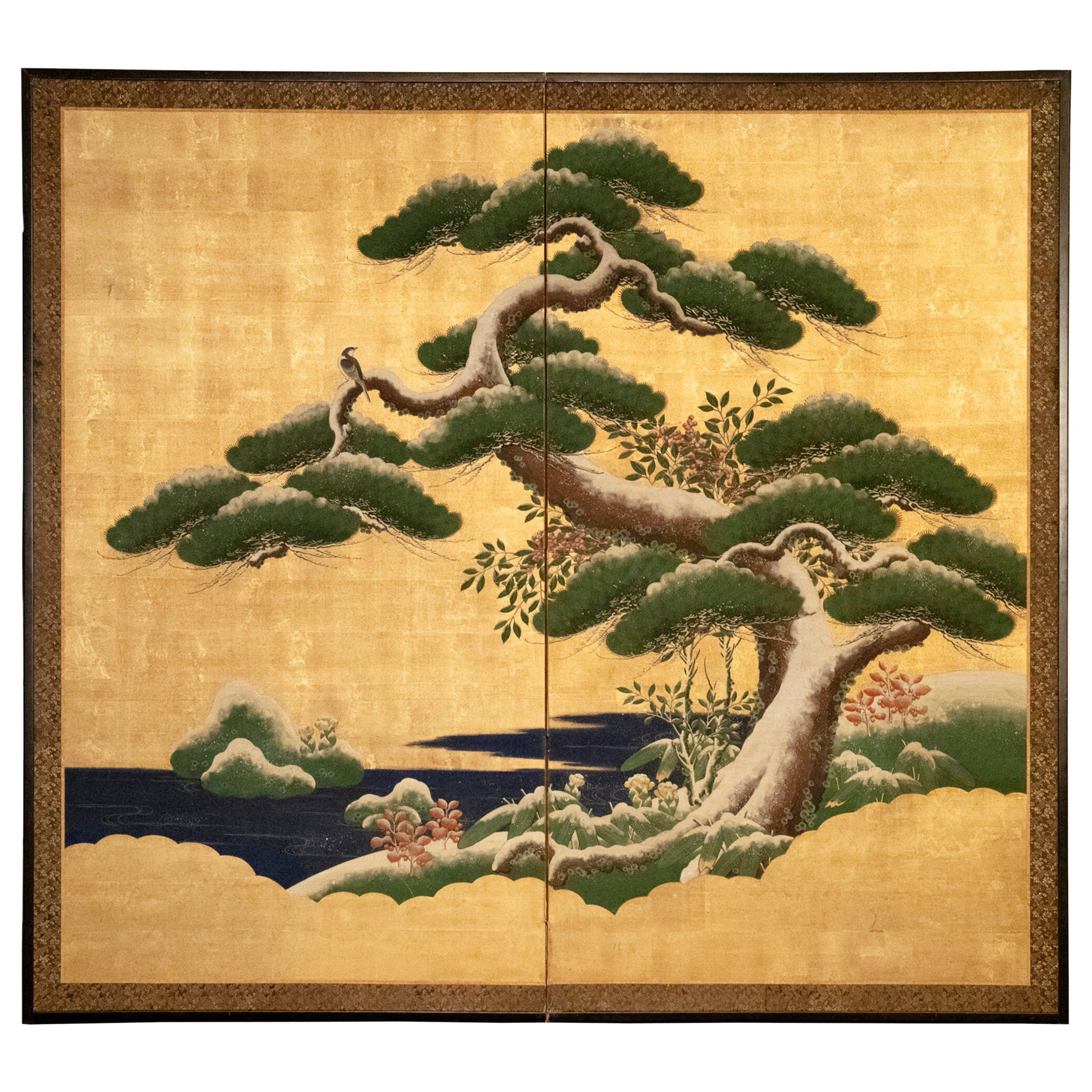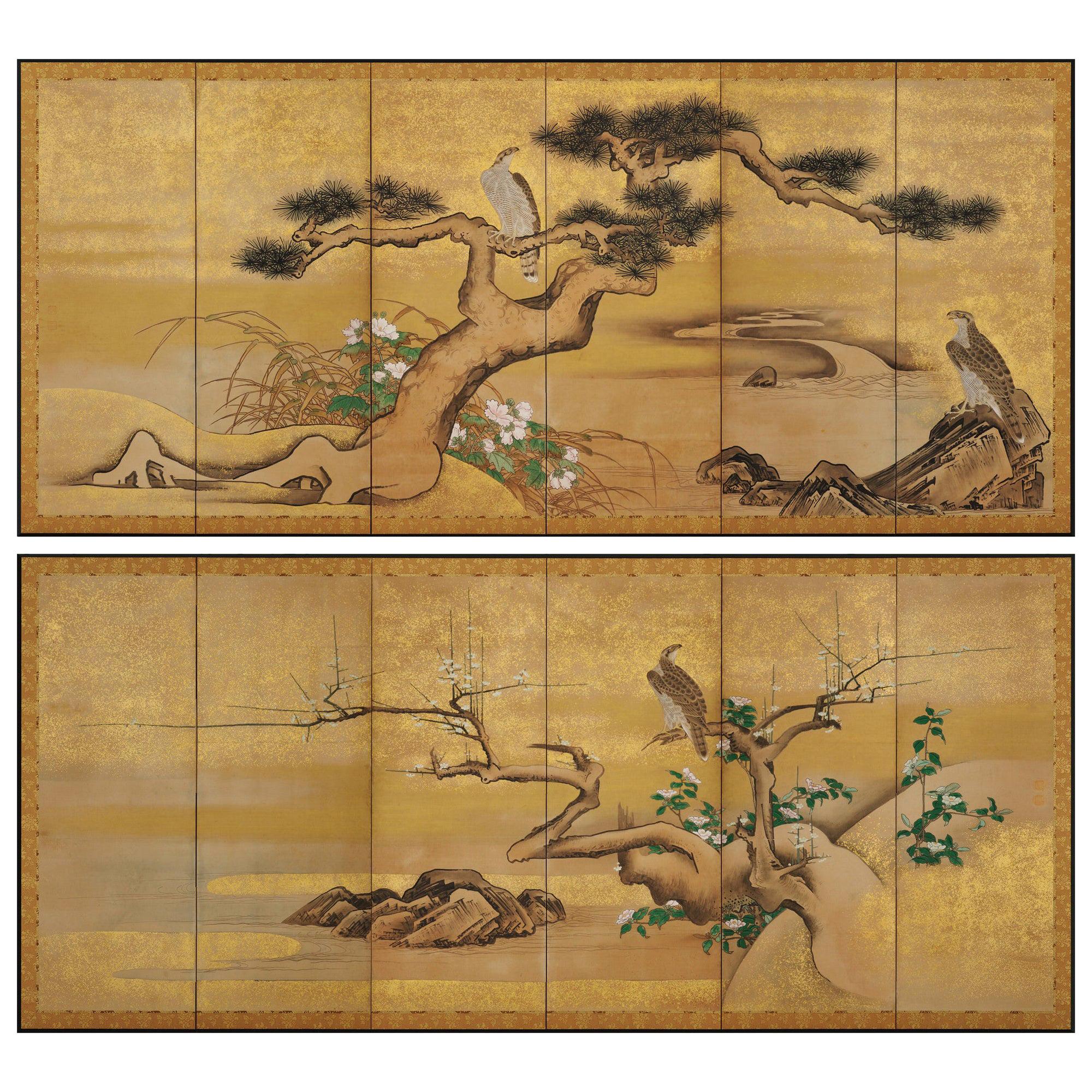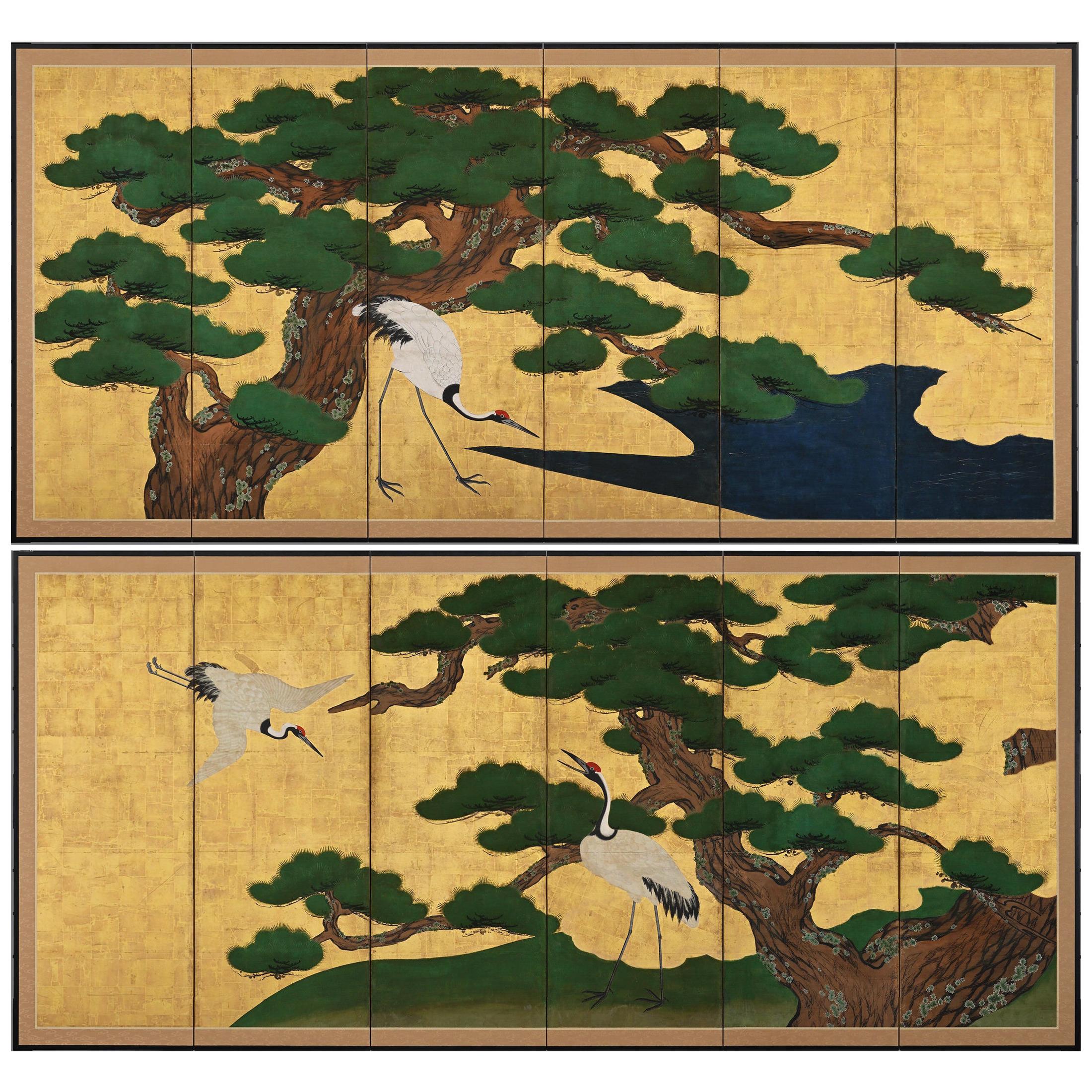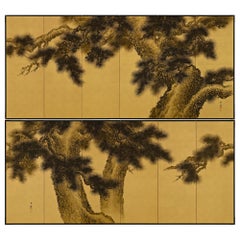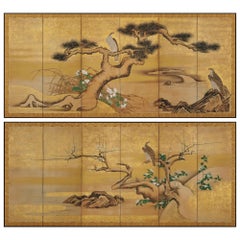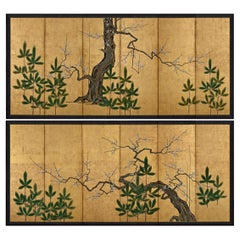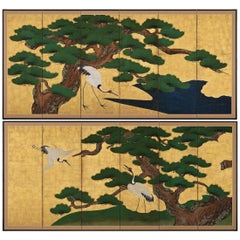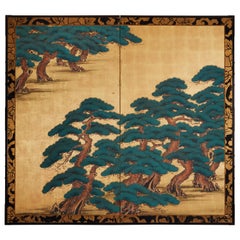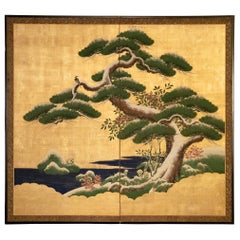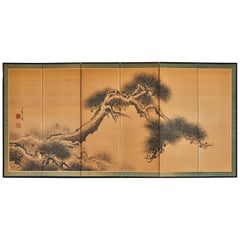Items Similar to Circa 1900 Japanese Pine Screen Pair. Aged Dragons by Suzuki Shonen.
Want more images or videos?
Request additional images or videos from the seller
1 of 11
Circa 1900 Japanese Pine Screen Pair. Aged Dragons by Suzuki Shonen.
$34,000per set
£25,994.81per set
€29,940.77per set
CA$47,644.42per set
A$53,190.52per set
CHF 27,871.03per set
MX$651,104.17per set
NOK 353,962.39per set
SEK 333,741.59per set
DKK 223,451.04per set
Shipping
Retrieving quote...The 1stDibs Promise:
Authenticity Guarantee,
Money-Back Guarantee,
24-Hour Cancellation
About the Item
Suzuki Shonen (1848-1918)
Aged Dragons
A pair of six-panel Japanese screens. Ink and gold leaf on paper.
Dimensions: Each Screen: H. 170 cm x 378 cm (67" x 149")
As with the pair of Suzuki Shonen pine screens in the collection of the Indianapolis Museum, this painting's title draws a comparison between these pine trees and ancient dragons. The pines' age is evident in their thick, moss-covered trunks and their imposing size, a fact underscored by the artist's deliberate cropping of their tops and bottoms to fit within the frame. Bold, expressive strokes of deep black ink define the robust trunks and sharp needles, creating a profound sense of grandeur. The artist skillfully employs different shades of ink to capture the many facets of the pine tree, from the rugged bark of its trunk and branches to the pine cones and needles, showcasing a masterful demonstration of skill and vitality.
The current pair of screens and the ones from Indianapolis exhibit remarkable similarities with regards to subject matter and composition yet the present screens are notably bolder and more expressive. The brushwork is more vigorous and the contrasts stronger. The black ink, particularly in the trunks, creates dramatic visual weight. The massive trunks anchor each screen, with heavy use of foreground space. The Indianapolis pair are slightly more refined and controlled with the lines more fluid and the transitions softened. They invoke a more quiet elegance rather than dramatic tension of the pair been presented here. For another very similar pair of ‘Aged Dragon’ pine screens by Suzuki Shonen, see a previously listed and sold pair on 1stdibs (also from my gallery). Shonen painted many pairs of screens during his lifetime and one of his most common themes was the pine tree, the “Sho” in his name, Shonen, being the Japanese character for “pine.”
Suzuki Shonen was one of the leading Japanese artists of the late 19th and early 20th centuries. He was continually active in major national and international exhibitions including the 1893 World’s Columbian Exposition in Chicago and the 1900 International Exposition in Paris. Shonen never worked from preliminary sketches, but painted quickly and directly, in a bold, individual style. Shonen’s great technical skill in handling ink tonalities and striking, forceful brushwork became the signal features of his style.
Pairs of six-panel pine screens by the artist are also held in the Metropolitan Museum of Art, New York and the Art Gallery of New South Wales.
- Dimensions:Height: 67 in (170.18 cm)Width: 149 in (378.46 cm)Depth: 0.75 in (1.91 cm)
- Sold As:Set of 2
- Style:Meiji (Of the Period)
- Materials and Techniques:
- Place of Origin:
- Period:
- Date of Manufacture:Circa 1900
- Condition:Wear consistent with age and use.
- Seller Location:Kyoto, JP
- Reference Number:1stDibs: LU2472345406562
About the Seller
5.0
Recognized Seller
These prestigious sellers are industry leaders and represent the highest echelon for item quality and design.
Established in 2001
1stDibs seller since 2016
70 sales on 1stDibs
Typical response time: 6 hours
- ShippingRetrieving quote...Shipping from: Kyoto, Japan
- Return Policy
Authenticity Guarantee
In the unlikely event there’s an issue with an item’s authenticity, contact us within 1 year for a full refund. DetailsMoney-Back Guarantee
If your item is not as described, is damaged in transit, or does not arrive, contact us within 7 days for a full refund. Details24-Hour Cancellation
You have a 24-hour grace period in which to reconsider your purchase, with no questions asked.Vetted Professional Sellers
Our world-class sellers must adhere to strict standards for service and quality, maintaining the integrity of our listings.Price-Match Guarantee
If you find that a seller listed the same item for a lower price elsewhere, we’ll match it.Trusted Global Delivery
Our best-in-class carrier network provides specialized shipping options worldwide, including custom delivery.More From This Seller
View AllEarly 20th Century Japanese Screen Pair - Ink Pine Trees on Gold
Located in Kyoto, JP
Imao Keisho (1902-1993)
Pine Trees
Early 20th Century, Circa 1930
Pair of six-panel Japanese screens. Ink on silk and gold leaf.
Dimensions: Each screen H. 67.5” x 148” (172 cm x 376 cm)
A pair of monumental six-panel Japanese pine screens by the renowned Nihonga artist Imao Keisho. Here Keisho entirely removed the background and brought the pine trees to the surface of the painting. This simplification of the elements makes the scene exceptionally direct and compelling and injects a very modern...
Category
Early 20th Century Japanese Showa Paintings and Screens
Materials
Gold Leaf
17th Century Japanese Screen Pair by Soga Nichokuan, Hawks on Pine & Plum Trees
Located in Kyoto, JP
Hawks on plum and pine
Soga Nichokuan (active circa 1625-1660)
Pair of six-fold screens.
Ink, mineral pigments, gofun, gold and speckled gold l...
Category
Antique 1640s Japanese Edo Paintings and Screens
Materials
Wood, Paper
18th Century Japanese Screen Pair. Plum & Young Pines. Kano School.
Located in Kyoto, JP
Dimensions (Each screen): H. 176 cm x W. 378 cm (69’’ x 149’’)
This pair of Japanese folding screens depict blossoming plum trees amongst young pines. They are designed to capture t...
Category
Antique Late 18th Century Japanese Edo Paintings and Screens
Materials
Gold Leaf
Circa 1700 Japanese Screen Pair, Cranes & Pines, Kyoto Kano School
Located in Kyoto, JP
Pines and Cranes
Anonymous. Kyoto Kano School.
Late 17th/early 18th centuries, circa 1700.
Pair of six-panel Japanese folding screens.
Ink, gofun, pigment and gold leaf on paper.
This bold composition presents two pine trees extending to the left and right across a gold leaf background. One tree is silhouetted against a green ground, golden clouds obscuring its true size, the other stretches across a stylized waterway. The pines are paired with Manchurian cranes with red crests and snow white plumage. Both have been highly auspicious motifs in East Asia since Chinese antiquity. Here the artist utilized fluid and instinctive ink brushstrokes to define the trunk, branches and tail feathers, in strong contrast to the precision and sharp angularity of the crane’s legs and beaks. The adoption of this vast metallic painting support required an unerring sense of design and composition, so that the negative space surrounding motifs could imply context for the otherwise floating pictorial elements. The brushwork detailing the trunks of the pines, the exaggerated dimensions of the pine trees and the strength and dynamism of the composition are all reminiscent of Kano Eitoku...
Category
Antique Late 17th Century Japanese Edo Paintings and Screens
Materials
Gold Leaf
Circa 1700 Japanese Sliding Door (Fusuma) Set. Pine Trees on the Seashore.
Located in Kyoto, JP
"Pine Trees on the Seashore"
A set of four sliding doors (Japanese fusuma). Ink, color, gold-leaf and gold-fleck on paper.
Dimensions (total display si...
Category
Antique Late 17th Century Japanese Edo Paintings and Screens
Materials
Gold Leaf
19th Century Japanese Screen Pair. Tiger & Dragon by Tani Bunchu.
Located in Kyoto, JP
Tani Bunchu (1823-1876)
Tiger and Dragon
A pair of six-panel Japanese screens. Ink on paper.
In this grand pair of Japanese Ryuko-zu screens the tiger crouches low to the ground, ...
Category
Antique Mid-19th Century Japanese Edo Paintings and Screens
Materials
Wood, Paper
You May Also Like
Japanese Two Panel Screen: Pine on Heavy Gold
Located in Hudson, NY
Kano School painting in mineral pigments on mulberry paper with heavy gold leaf and a silk brocade border made of antique monk's robes.
Category
Antique Late 19th Century Japanese Paintings and Screens
Materials
Gold Leaf
Japanese Two Panel Screen: Pine in Snow
Located in Hudson, NY
Kano School, Mineral pigments on gold leaf with silk brocade border and lacquer wood trim.
Category
Antique Mid-19th Century Japanese Paintings and Screens
Materials
Gold Leaf
Japanese Six Panel Screen: Ink Painting of a Weathered Pine Tree
Located in Hudson, NY
Meiji period (1868 - 1912) sumi-e (or ink painting) on paper of a venerable pine tree with limbs stretching out over a bluff. Beautiful signature and seal read: Biei. Ink on paper ...
Category
Antique 19th Century Japanese Paintings and Screens
Materials
Brocade, Silk, Paper
Pair of 18th Century Japanese Edo Screens of Chinese Immortals
Located in Rio Vista, CA
Mesmerizing pair of late 18th/early 19th century Japanese Edo period byobu screens by Shibata Gito (Japanese 1780-1819). The paintings depict Chinese immortals in a dreamy landscape....
Category
Antique 18th Century Japanese Edo Paintings and Screens
Materials
Silk, Wood, Paper
Japanese Antiques Pine Trees, Panel Painting/Sliding Door Painting, 2 Pieces set
Located in Niiza, JP
The material is thought to be cedar or cypress.
925 (W) x 1775 (H) x 30 (D) [mm] *Size of one piece 7㎏/per
The color is well preserved.
A colorful wooden door fitting with gold sand...
Category
20th Century Japanese Paintings and Screens
Materials
Wood
Pair of Japanese Edo Six Panel Screens the Seven Sages
Located in Rio Vista, CA
Fantastic pair of 19th century Japanese late Edo/early Meiji period six-panel screens titled The seven sages of the bamboo grove. The Kano school screens...
Category
Antique 19th Century Japanese Edo Paintings and Screens
Materials
Brass, Gold Leaf
More Ways To Browse
Japan 1900
Space Age Gallery
Japanese Dragon
Antique Japanese Dragon
Painting Antique Pine Furniture
Antique Moss
Antique Bark
Gold Tree Trunk
Pair Of Japanese Screens
Used Furniture Indianapolis
Japanese Trunk
Hand Painted Antique Trunks
Asian Dragon Paintings
Japanese Screens Pines
Gold And Black Trunk
Japanese Tree Bark
Japanese Dragon Painting
Gold Leaf Dragon
